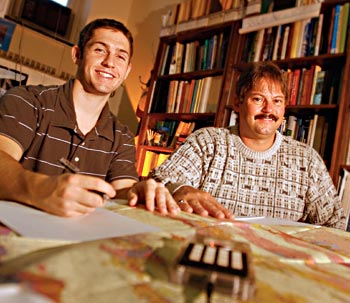Geology major Daniel Latham ’04 (Islip Terrace, N.Y.) is examining the effects of wildfires as part of an intensive summer-long research project.
A participant in Lafayette’s EXCEL Scholars Program, Latham is working with Dru Germanoski, professor and head of geology and environmental geosciences. In EXCEL, students assist faculty with research while earning a stipend.
Their coauthored paper, “The Importance of Event Sequencing on the Geomorphic Impact of Wildfire in the Central Great Basin,” will be published in GSA Abstracts with Programs Vol. 34, No. 6, next month.
Latham is working to determine the percentage composition of pebbles, clays, and sands in soil samples taken from Great Basin, Nev. He and Germanoski spent two weeks in June investigating the prescribed burn in Underdown Canyon and collecting data in Wall Canyon, a drainage basin burned by a lightning-generated wildfire in 2000. The work was part of the Great Basin Ecosystem Management Project, a collaborative research effort involving geologists from universities, USDA Forest Service, and the Ecology Team from Humboldt-Toiyade National Forest.
“We have several projects that are ongoing,” explains Germanoski. “Dan worked with me on the Joint Fire Sciences Project. We established a number of transects on hill slopes throughout the drainage basin and surveyed the soil surface along each transect to serve as a baseline for measuring any future soil erosion resulting from the fire.”
Wildfire leads to accelerated soil and channel erosion when destruction of vegetation produces more runoff when it rains or snowmelt occurs in the spring. Vegetation protects soil from erosion by intercepting precipitation and binding soil particles together. When fire destroys the vegetation, this armor effect is removed.
“No significant erosion has occurred in Wall Canyon subsequent to the fire. I believe this is because the past two years have been average or below average with respect to precipitation,” says Germanoski. “However, if a large snow pack develops or if rainfall is heavy in the spring or summer, the drainage basin may still respond, so by measuring hill slope and channel cross sections, we will have a datum or reference point to measure future change.”
To determine percent composition, Latham places the samples in water to remove broken twigs and sediment, removes moisture by placing the samples in an oven, and then shakes up the remainder and weighs the material. Latham’s results will be compared to samples taken next year.
“Dan is measuring the grain size distribution as a reference point for future change also,” says Germanoski. “If soil erosion becomes significant, we will be able to assess what particle sizes were preferentially eroded. Often, the finer particles (clay, silt, sand) will be eroded preferentially, leaving a coarse gravel lag deposit behind. Thus, the soil texture may change.”
In conjunction with his research on wildfires, Latham also took part in the Wet Meadows Project.
“In the mountains, the snowmelt forms wet meadows and streams run through them,” he explains. “The streams are sinking deeper and deeper, the water table is getting lower, and the meadow is drying out.”
Germanoski says that through this EXCEL project, Latham learned surveying techniques using a total station laser surveying system, how to use an electronic digitizer to collect morphometric data from topographic maps, and how to conduct particle size analysis to characterize the texture (percentage of gravel, sand, silt, and clay) that comprises a soil or sediment layer. Also, he learned basic field geology such as how to make and record observations and measure stream channel cross-sections.
For Latham, this was his first trip to the western part of the country and his first academic research trip. Latham and Germanoski lived with a group of other geologists and their students from around the country doing academic research in a house owned by the U.S. Forest Service in Austin, Nev.
Latham says that he appreciates this research opportunity because it is preparing him for his future career as an environmental consultant.
“Professor Germanoski is a brilliant thinker,” he notes. “When the intellectual conversations were flying, I thought, ‘When do I get to do that?'”
“Dan is very bright,” says Germanoski. “I am always impressed with his ability to learn new skills quickly. He only has to be told things once and he catches right on. Normally, a person has to be coached through measurement techniques or surveying procedures several times before they catch on, but with Dan, once was usually sufficient. He also extrapolates one experience to the next.”
Germanoski says that he has been fortunate to have several great students work in Nevada with him.
“Dan is the fourth in a succession of bright Lafayette students who have worked in Nevada with me,” he says.
Latham has made the dean’s list for the past two semesters and is a member of Phi Kappa Psi fraternity.

A National Leader in Undergraduate Research. Daniel Latham ’04 coauthored an article on his joint research with Dru Germanoski, professor of geology and environmental geosciences, in The Geological Society of America Annual Meeting Abstracts.
